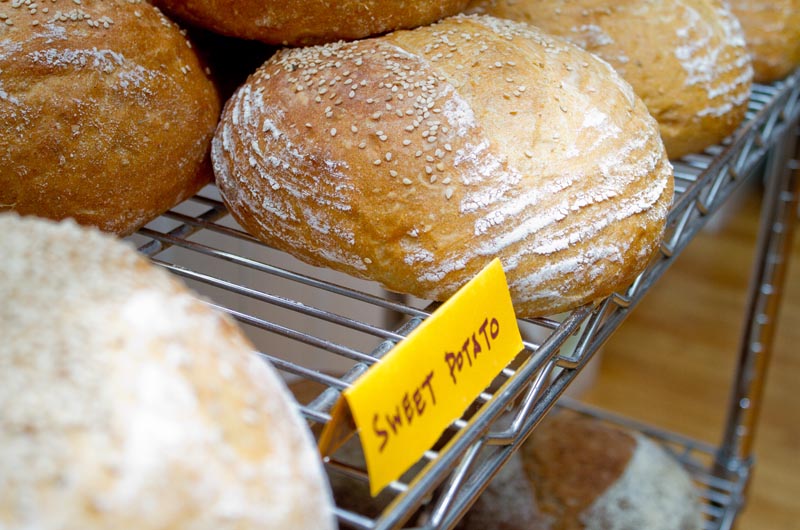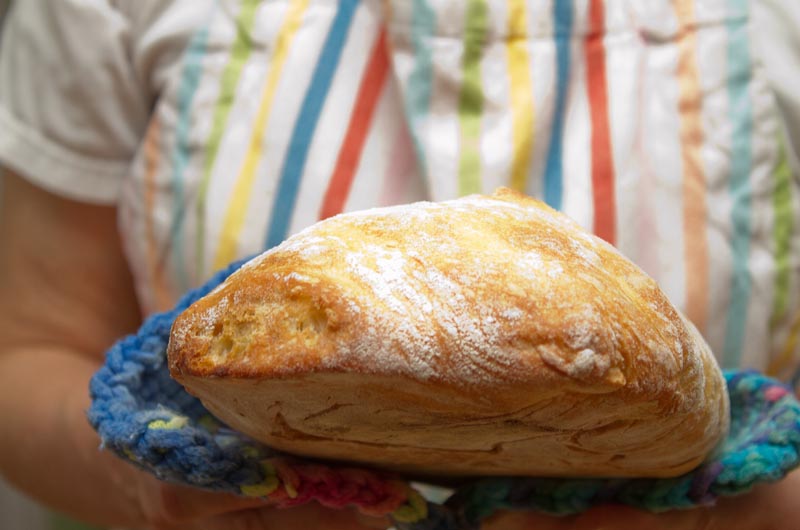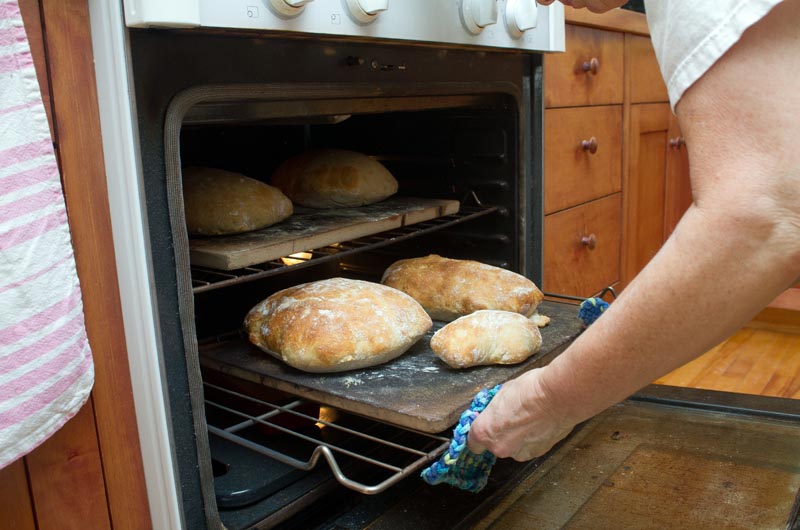Most Fridays, Kate Warner can be found in her West Tisbury kitchen. Even in early December, the room is hot; sun streams in through tall windows and inside two knee-level ovens, bread is baking.
On a recent Friday Ms. Warner wore a rainbow-striped apron when she baked three organic breads from scratch: ciabatta, multigrain and sweet potato.
In the afternoon, she welcomes a few dozen clients into her home to pick up their weekly share of her baking harvest — two loaves for some, more for others.
The small venture is now certified as a residential kitchen, a board of health designation which allows Ms. Warner to bake up to 100 loaves a day, two days a week, and sell them commercially.
She can now invite more people to participate in what she calls her community-supported bread project, which operates much like a farm share or CSA.
Clients order a minimum of two loaves every week or every other week, and pick them up on Friday afternoon, bringing their own bags and paying around $12 to $20, depending on how many loaves they have ordered.
An architect and avid environmentalist, Ms. Warner began baking bread as a teenager. The Tassajara Bread Book still stands on her kitchen bookshelf, keeping good company with other baking books she’s collected over the years. Decades later, she studied baking in Bath, England, and returned home to bake bread each week for a group of friends.
“My idea is that I want to practice, and I want to experiment using different flours, and using different methods,” she said.
She bakes with exclusively organic ingredients, and makes efforts to involve the consumers of her product in the learning.
Solar panels installed on her property provide power for her electric oven. She sees the project as a way to increase awareness of climate change, which she says can be a depressing topic.
“The more I can develop my technique and the more local the whole thing becomes, the more it gives people a way to connect to something,” she said. The best candidates for the bread project live nearby, as participants are required to come to her house each week during a two-hour window. “The closer you live to here, the better,” she said. “The pickup is the weak link of the idea.”
Beginning next year, she plans to add Tuesday as a second baking day now that her kitchen is certified.
The bread project is not very profitable (she estimates that after about 12 hours preparing, baking and distributing her breads, she pockets about $200), but Ms. Warner is unfazed.
“This is not a production bakery,” she said. “It’s a learning lab.”
She looks to her customers for feedback; they are her partners in the venture. They love her cinnamon raisin bread best and order the multigrain with regularity, but she is constantly exploring new formulas. Recently she tried a new five-seed bread and it didn’t come out as hoped; it was too dense and it seemed to have too much seed in the mixture.
The next time she tries a new formula on the fly, she will offer it not as part of the weekly bread share, but as a sample for her customers to try out, she said.

Her next frontier is baking with ancient grains. These are little known wheat varieties like einkorn, spelt and kamut, which tend to be easier to digest for those with gluten intolerance (though they are not for people with celiac disease.)
Ms. Warner the architect approaches baking with a mathematical mindset. To her, the formula is another kind of blueprint.
“It’s a very accurate sport, baking,” she said. “The more accurate you are, the better.”
Her process begins the day before the bake, when she weighs the flour. She uses a proofing schedule to time each of the steps — mixing, fermentation, and baking among them.
By 1 p.m., neat rows of multigrain sit cooling on a rack, sweet potato dough is rising on the kitchen table and warm, yeasty smells permeate the kitchen.
She carves a deep cut in the top of the loaves before they go in the oven; this prevents cracks in less desirable places. “We are giving this bread a spot to rise up and crack,” she said.
Once the bread is in the oven, she sets trays of ice in the bottom of the oven to make the bread crusty. The ice sizzles, surrounding the loaves with a bit of steam. Ms. Warner bakes her loaves on a hot stone, and when the dough makes contact, it springs up, creating a pleasing rounded top.
In many ways, the community bread project is a return to the past, she said.
Her grandparents were Jewish immigrants who lived on the Lower East Side of Manhattan. In those days, hardly anyone had an oven of their own. Instead, they brought dough or casseroles to the communal oven for baking. There is an international movement to return to this model and create a microbakery in each community.
Down the road, Ms. Warner would like to build on the local emphasis of her venture by baking with wheat that’s grown on the Island.
Once the sweet potato loaves are in the oven, she is left with two ciabatta doughs — one which she folds over itself inside a plastic dough tub. The other ciabatta loaf had been split into eight parts, which sat in a grid formation on the floured linen cloth.
Within hours, the loaves would disappear from the kitchen, save perhaps some multigrain she keeps for herself.








Comments (5)
Comments
Comment policy »